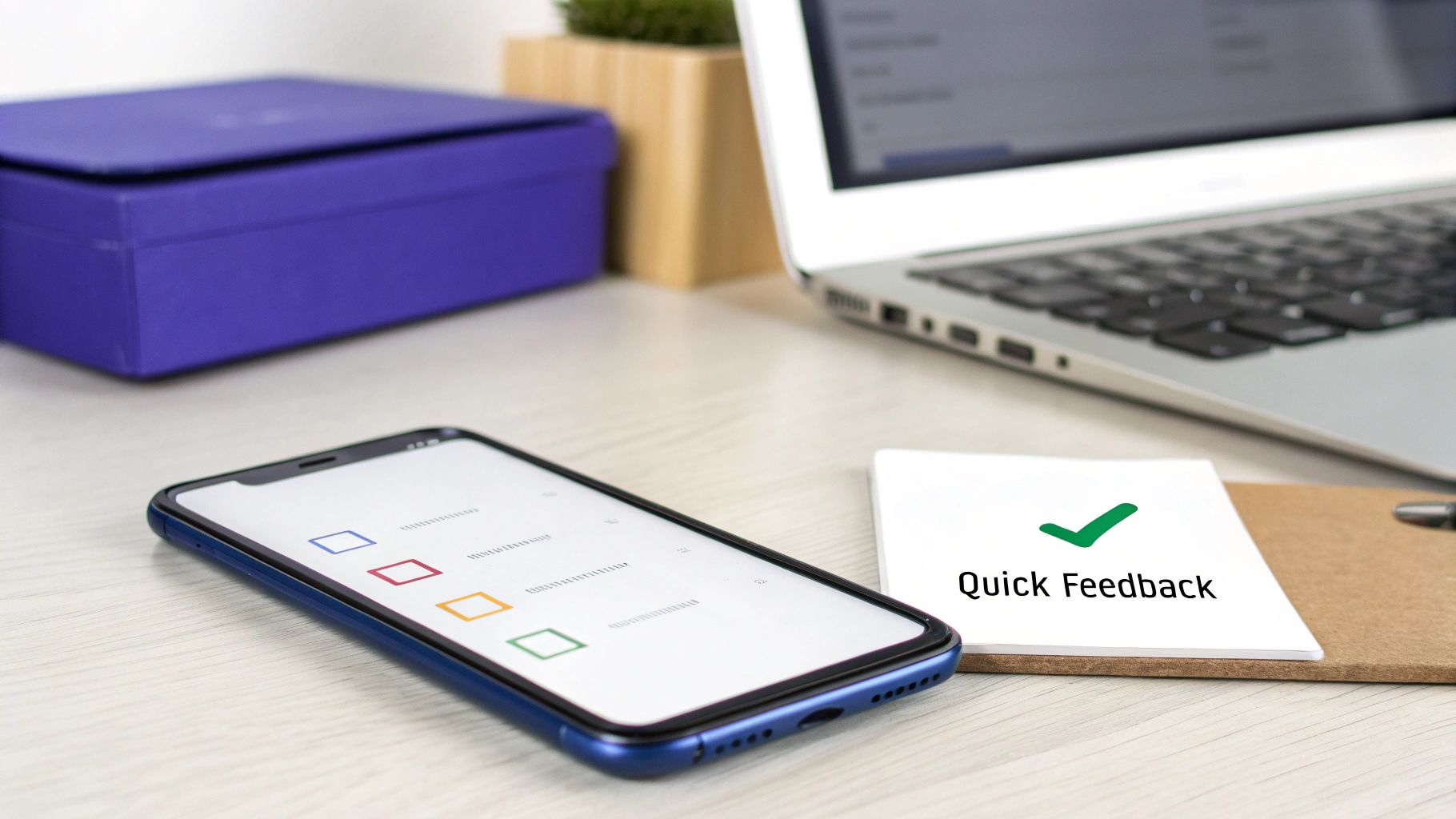6 Actionable Exit Survey Examples for SaaS in 2025
Discover 6 expert-backed exit survey examples to reduce SaaS churn. Get actionable templates and insights to improve retention and product strategy.

Unlocking Retention: Why Your SaaS Needs Smarter Exit Surveys
Customer churn is a silent killer in the SaaS industry, directly eroding revenue and stalling growth. While losing some customers is inevitable, understanding why they leave is your most powerful tool for prevention. This is where the exit survey comes in, but not the generic, check-the-box form you’re used to. A modern exit survey, integrated directly into your cancellation flow, is a critical business intelligence asset. It's your last chance to uncover product gaps, pricing friction, or competitive threats straight from the source.
Most companies fail here, using outdated questions that yield vague, unactionable data. The result? A missed opportunity to fix the core issues driving users away. Understanding why customers leave is crucial for implementing effective retention strategies. For more insights on this critical area, explore these proven strategies to reduce customer churn.
This article provides six distinct exit survey examples designed specifically for the modern SaaS landscape. We will move beyond traditional HR formats to give you actionable templates you can deploy immediately. We’ll analyze each example, breaking down the strategy behind the questions and showing you how to adapt them to your specific needs. The goal is to transform your offboarding process from a simple goodbye into a powerful engine for churn deflection and continuous product improvement.
1. Traditional HR Exit Interview Survey
While our primary focus is on SaaS churn deflection, understanding the roots of exit surveys provides a powerful foundation. The Traditional HR Exit Interview Survey is the classic, comprehensive model used by human resources departments for decades to understand employee turnover. It’s a structured conversation or detailed questionnaire designed to gather in-depth feedback on an employee's entire experience, from job satisfaction and management effectiveness to company culture and compensation.

This method isn't just for large enterprises; its principles are highly adaptable for understanding "employee churn" within a SaaS context, particularly for high-value B2B accounts where a key user or champion leaves the client company. These exit survey examples often feature a mix of scaled-response questions (e.g., "Rate your manager's effectiveness on a scale of 1-5") and open-ended questions ("What could have been done to improve your experience?").
Strategic Analysis & Use Case
The core strength of the HR model is its depth. It’s not just about the final reason for leaving; it’s about uncovering the entire journey that led to that decision. For SaaS, this translates to understanding the "user journey" that culminates in churn.
When to Use It: This comprehensive approach is ideal for high-ARPU (Average Revenue Per User) customers or strategic accounts. When a power user or the primary decision-maker at a key client churns, a more detailed, "HR-style" exit survey can uncover deep-seated issues that a simple multi-choice form would miss. Think of it as an "account post-mortem."
Why It's Effective: It moves beyond surface-level reasons like "too expensive" to reveal underlying problems in onboarding, support, feature adoption, or a failure to demonstrate ROI. Companies like General Electric and IBM have long used these surveys to pinpoint systemic issues in management and internal processes, a strategy directly applicable to identifying systemic flaws in a SaaS product or customer success process.
Actionable Takeaways
To adapt this HR method for your SaaS churn flow, consider these tactics:
- Segment Your "Employees": Don't send a 30-question survey to every user who cancels a $10/month plan. Reserve this in-depth approach for your most valuable, long-term, or enterprise-level customers.
- Combine Methods: Pair a detailed online questionnaire with an offer for a brief call with a senior customer success manager. This mimics the HR practice of combining written surveys with face-to-face interviews, capturing both quantitative data and qualitative nuance.
- Focus on the "Job-to-be-Done": Frame your questions around the "job" the customer hired your software to do. Ask about their "manager" (your support team), their "coworkers" (collaboration features), and their "career growth" (achieving business goals with your tool).
2. Anonymous Digital Exit Survey
Moving from the high-touch, personal approach to a more scalable model, the Anonymous Digital Exit Survey leverages technology to gather candid feedback. This method prioritizes confidentiality and convenience, using online platforms like SurveyMonkey, Typeform, or specialized HR tools like Culture Amp. The survey is typically delivered automatically via email upon cancellation or offboarding, allowing a user to provide honest feedback without the pressure of a direct conversation.

This technology-driven approach is a staple for modern SaaS companies and was heavily popularized by Google's data-centric People Operations team. The core idea is that anonymity encourages more truthful, less filtered responses. For SaaS businesses, this means users might be more willing to admit they found the UI confusing or that a competitor's feature was the real reason for leaving, rather than defaulting to a polite, generic reason like "it wasn't a good fit." These digital exit survey examples are designed for efficiency and high completion rates.
Strategic Analysis & Use Case
The primary strength of the anonymous digital survey is its ability to collect a high volume of data with minimal friction. This scale allows for quantitative analysis to spot trends that wouldn't be visible from just a few in-depth interviews. It's about statistical significance over individual nuance.
When to Use It: This is the go-to method for most B2C or high-volume B2B SaaS products. If you have hundreds or thousands of users churning per month, an automated, anonymous survey is the only practical way to gather feedback at scale. It’s perfect for products with low-to-mid ARPU, where the cost of a one-on-one call would outweigh the customer's value.
Why It's Effective: Anonymity breaks down psychological barriers. A user who doesn't want to seem "cheap" in a call will happily select "pricing" as their reason in an anonymous form. This method generates cleaner, more honest data for product, marketing, and success teams to act on. Remote-first companies and modern tech startups rely on this method as their primary feedback channel, integrating results directly into dashboards for real-time analysis. For more inspiration, you can review this detailed exit survey form guide to build your own.
Actionable Takeaways
To effectively implement an anonymous digital survey for your SaaS churn, focus on automation and clarity:
- Automate the Trigger: Integrate your survey tool with your billing or CRM system. The survey should be sent automatically the moment a user cancels their subscription. This ensures timely feedback while the experience is still fresh.
- Use Conditional Logic: Don't ask every user the same questions. Use "skip logic" to create a personalized path. If a user selects "pricing" as the reason for leaving, follow up with questions about perceived value or specific competitor pricing, not questions about feature gaps.
- Optimize for Brevity: Keep the survey under 10 questions and ensure it can be completed in less than five minutes. A long survey is an abandoned survey. Use a mix of multiple-choice questions for easy data aggregation and one or two optional open-ended questions for deeper insights.
3. Stay Interview-Style Exit Survey
Shifting from a retrospective to a proactive stance, the Stay Interview-Style Exit Survey reframes the entire conversation. Instead of just documenting the reasons for departure, this method, pioneered by retention experts like Beverly Kaye and Sharon Jordan-Evans, focuses on understanding what could have prevented the exit. It’s a conversational, future-focused approach that treats a departing employee (or customer) as a valuable source of intelligence for improving the experience for those who remain.
This model is less of a rigid questionnaire and more of a guided dialogue. The core premise is that the departing individual likely thought about leaving long before they acted. These exit survey examples aim to uncover those earlier inflection points. For a SaaS business, this means discovering the "near-churn" moments and understanding what factors could have re-engaged the user or strengthened their commitment to the product.
Strategic Analysis & Use Case
The strategic power of this method lies in its emphasis on generating immediately actionable feedback. It’s not about blame; it’s about proactive improvement. Instead of learning why a customer left, you learn how you could have made them stay, which is a far more powerful insight for your product and customer success teams.
When to Use It: This approach is exceptionally effective for customers who showed high engagement or were previous champions before their usage dropped off. It's also invaluable for mid-market or enterprise accounts where the relationship is more personal. If a previously happy customer suddenly cancels, this method helps you understand the specific trigger or unmet need that broke their loyalty.
Why It's Effective: It changes the tone from an autopsy to a consultation. By asking "What could we have done differently to keep your business?" you solicit constructive, forward-looking advice. Salesforce is known for applying these principles in both its internal HR and customer success processes to understand loyalty drivers. This approach uncovers nuanced issues like a key feature's declining value, a competitor's superior workflow, or a failed "job-to-be-done" that a standard survey would miss.
Actionable Takeaways
To implement a Stay Interview-Style survey in your SaaS churn flow, focus on empathy and future-oriented questions:
- Reframe the Core Question: Shift from "Why are you canceling?" to questions like, "Was there a specific moment or challenge that made you first consider alternatives?" or "What would a 'perfect' solution for this problem look like for you?"
- Train Your Team: This method works best as a real conversation. Train your customer success or account managers in active listening and empathetic communication. Their goal isn't to win back the customer in that call but to gather honest, actionable intelligence.
- Create a Rapid Feedback Loop: The insights gathered are time-sensitive. Document specific recommendations and share them with product, marketing, and support teams within 48 hours. The goal is to quickly translate the learnings into roadmap adjustments or improved support protocols to prevent the next customer from facing the same issue.
4. Role-Specific Exit Survey
Moving beyond a one-size-fits-all approach, the Role-Specific Exit Survey customizes feedback collection for different user personas or account types. Just as an HR department wouldn't ask a software engineer and a salesperson the exact same questions about their tools and daily challenges, a SaaS company shouldn't treat a casual user the same as a power-user administrator. This method involves a core set of universal questions combined with specific modules relevant to a user's role or usage level.
This strategy recognizes that different users have unique "jobs-to-be-done" with your product. For example, a marketing manager using an analytics tool cares about campaign ROI and reporting features, while a data analyst using the same tool is focused on API access, data integrity, and query speeds. These exit survey examples use conditional logic to present relevant questions, creating a more pertinent and insightful feedback experience.
Strategic Analysis & Use Case
The primary advantage of this model is its precision. It allows you to diagnose churn reasons with a level of granularity that a generic survey cannot achieve. You can pinpoint whether a feature gap is impacting a specific user segment or if a pricing issue is only a deterrent for smaller, single-seat accounts.
When to Use It: This is perfect for SaaS products with diverse user bases or multiple user roles within a single client account (e.g., admins, editors, viewers). It's also highly effective for platforms serving different industries, where the value proposition and key features vary significantly between sectors.
Why It's Effective: It prevents feedback fatigue and generates higher-quality data. Users are more likely to complete a survey that feels relevant to their specific experience. Technology companies like Asana or Jira might use this to differentiate feedback from project managers versus individual contributors, uncovering role-specific friction points that could lead to team-wide churn.
Actionable Takeaways
To implement a role-specific churn survey, focus on segmentation and relevance:
- Start with a Universal Core: Establish a baseline of 5-7 essential questions that every canceling user receives. These should cover overall satisfaction, the primary reason for leaving, and key competitor alternatives.
- Develop Role-Based Modules: Work with your product and customer success teams to identify the top 3-4 key activities or features for each major user persona. Build short, targeted question modules around these areas. For an e-commerce platform, this could mean separate modules for "Store Owners" and "Marketing Agencies."
- Use Conditional Logic: Implement survey logic that automatically routes users to the correct module based on their user role, subscription plan, or even specific feature usage data you've collected. This streamlines the experience and ensures you're only asking what's necessary.
5. Post-Departure Follow-Up Survey
The Post-Departure Follow-Up Survey is a sophisticated, two-phase system that extends the feedback loop beyond the immediate point of cancellation. This method involves sending an initial exit survey right after a customer churns, followed by a second, more reflective survey 30 to 90 days later. This delayed approach is designed to capture a different, often more objective, set of insights once the initial frustration has subsided and the user has experienced alternative solutions.
This strategy recognizes that a customer's perspective changes over time. Immediately after churning, their feedback might be driven by a specific, recent negative experience. Weeks later, after they’ve settled in with a competitor (or failed to find a suitable replacement), their view of your product's strengths and weaknesses becomes much clearer and more comparative. These delayed exit survey examples are typically shorter and more focused on competitive intelligence.
Strategic Analysis & Use Case
The power of the follow-up survey lies in its ability to gather honest competitive analysis and benchmark data. The initial churn reason might be "price," but the follow-up can reveal the real story: "Your competitor's onboarding was faster," or "I realized I didn't actually need 80% of your features."
When to Use It: This is a goldmine for highly competitive SaaS markets. It's particularly effective for customers who were mid-to-high value and had been with you for a significant period. Their post-churn perspective provides invaluable intel on how your product truly stacks up against the alternatives they are now using.
Why It's Effective: It separates emotional, heat-of-the-moment feedback from considered, rational comparison. Consulting firms like McKinsey & Company have long used alumni networks and follow-up contacts to track career progression and gather market intelligence. For SaaS, this translates to tracking the "career" of a user's problem after they've "fired" your tool, giving you a direct window into your competitors' value propositions and user experiences.
Actionable Takeaways
To implement a successful two-phase survey system, focus on maintaining the relationship and making participation easy:
- Keep It Short and Sweet: The follow-up survey must be significantly shorter than the initial one. Focus on 3-5 key questions, such as "What solution are you using now?", "What's the one thing it does better?", and "What's one thing you miss about our product?"
- Offer a Clear Incentive: Acknowledging that their time is valuable is crucial. Offer a small but meaningful incentive for completing the second survey, like a gift card, a free industry report, or a donation to a charity of their choice. This shows goodwill and dramatically increases response rates.
- Frame It as a Relationship: Don't position it as just another survey. Frame the outreach as a check-in from a former partner interested in their progress. This "alumni network" approach fosters a positive long-term relationship, leaving the door open for them to return in the future. Effective data analysis for surveys is critical here to compare initial and follow-up responses for deeper insights.
6. Pulse-Style Micro Exit Survey
Drawing inspiration from the high-frequency, low-friction nature of employee pulse surveys, the Pulse-Style Micro Exit Survey is a condensed, rapid-fire approach to gathering churn feedback. This format typically consists of just 5-10 essential questions that a user can answer in under five minutes. The primary goal is to maximize response rates by minimizing user effort, while still capturing critical data points on the most significant drivers of churn.

This method is particularly effective for SaaS models with high user volume and potentially lower individual contract values, where getting any feedback is better than getting none at all. These exit survey examples prioritize speed and ease of completion, trading the depth of a traditional survey for a higher volume of responses. Think of companies in the gig economy or B2C apps that need to quickly understand why thousands of users might be dropping off each month.
Strategic Analysis & Use Case
The strategic advantage of the micro-survey is its efficiency and the resulting high response rate. While it won't uncover complex, multi-faceted issues like an in-depth interview, it provides a powerful, real-time pulse on the most common and immediate reasons for churn, allowing for quick trend analysis and data-driven adjustments.
When to Use It: This is the perfect model for freemium products, low-ARPU subscription services, or any SaaS with a large, self-service user base. It's ideal for capturing feedback at scale where a one-to-one conversation is impossible. It’s also excellent for mobile apps where users have a low tolerance for long forms.
Why It's Effective: Its brevity respects the user's time, drastically increasing the likelihood of completion. This approach, popularized by HR analytics firms for high-turnover industries like call centers, gives you a statistically significant dataset on top-line churn reasons. This allows product and marketing teams to quickly spot and react to emerging problems, like a buggy feature release or a new competitor's compelling offer.
Actionable Takeaways
To implement a pulse-style survey that delivers maximum insight with minimum friction, follow these tactics:
- Isolate Critical Factors: Don't try to ask about everything. Identify the 3-5 most critical potential churn drivers for your business (e.g., price, specific feature gaps, usability, support quality) and focus your questions exclusively on them.
- Use Benchmarking Questions: Incorporate a Net Promoter Score (NPS) style question like, "How likely were you to recommend us before you decided to cancel?" This provides a consistent benchmark to track over time.
- Mandate One Open-Ended Question: While most questions should be multiple-choice for speed, always include one optional, open-ended question like, "If you could change one thing about our service, what would it be?" This provides a crucial outlet for qualitative insights you hadn't considered. For more tips, you can improve your survey response rate with Surva.ai.
Exit Survey Types Comparison
From Feedback to Flywheel: Activating Your Exit Survey Data
Throughout this deep dive, we've dissected a variety of powerful exit survey examples, moving far beyond generic templates. From the detailed insights of a traditional HR survey to the real-time, actionable nature of a pulse-style micro-survey, the common thread is clear: the question is just the beginning. The true value isn't in asking "why are you leaving?" but in what you do with the answer. Collecting feedback without a system to analyze and act upon it is like collecting treasure but leaving it buried. The real magic happens when you transform that raw data into a proactive, churn-deflecting growth engine.
The strategic pillars supporting this transformation are segmentation, automation, and targeted action. You saw how role-specific surveys can uncover unique pain points for different user personas and how stay-interview style questions can pre-emptively address issues before they become deal-breakers. The goal is to move from a one-size-fits-all approach to a highly contextual, personalized dialogue with your departing users.
The Closed-Loop Imperative: Survey, Analyze, Act, Measure
A world-class retention strategy is built on a continuous, closed-loop process. This is where the examples we've explored come to life.
- Survey: Deploy the right survey at the right moment. Whether it's a multi-step survey embedded in your cancellation flow or a post-departure follow-up, the initial data capture must be intentional and well-timed.
- Analyze: This is where raw answers become strategic insights. Segmenting feedback by user cohort, subscription plan, or product usage patterns reveals the real stories behind your churn numbers. To truly activate your exit survey data, leveraging advanced analytical tools, including AI, can provide deeper insights. Understanding the mechanisms behind these tools is key to building trust in AI-driven data analysis and ensuring you can confidently act on its recommendations.
- Act: Your analysis must trigger a specific, automated response. A user citing "too expensive" should be met with a discount offer or a downgrade path. A user confused about features should be directed to a support document or a live chat with a success manager. This is where you turn a potential churn event into a retention opportunity.
- Measure: Finally, track the effectiveness of your interventions. How many users who saw the discount offer accepted it? Which support articles were most effective at saving accounts? This data feeds back into the loop, allowing you to constantly refine and optimize your surveys and automated responses.
Your Challenge: From Reading to Doing
Mastering this flywheel gives your organization a formidable competitive advantage. It directly impacts your bottom line by reducing churn, increases customer lifetime value, and provides invaluable feedback for your product roadmap. The exit survey examples in this article are not just concepts; they are blueprints for action.
Your challenge is to move beyond passive data collection. Don't let this knowledge sit idle. Choose one strategy from this article that resonates most with your current challenges, whether it's implementing a pulse-style micro survey or refining your long-form questionnaire, and commit to deploying it within the next 30 days. Start small, measure the impact, and build from there. The journey from feedback to a powerful growth flywheel begins with that single, decisive step.
Ready to build a retention engine that acts on feedback in real-time? Surva.ai provides the tools to create intelligent, contextual exit surveys and automate the churn-deflection actions that turn insights into saved customers. Move beyond static forms and start building your feedback flywheel today.


